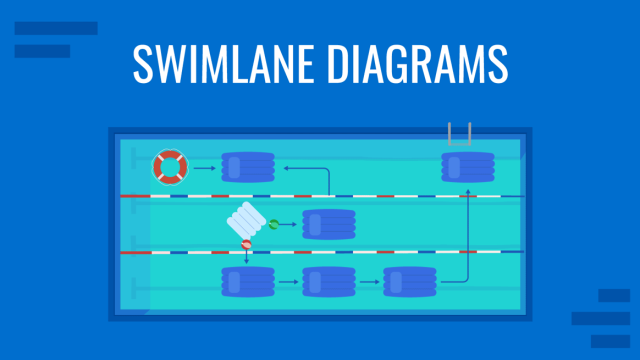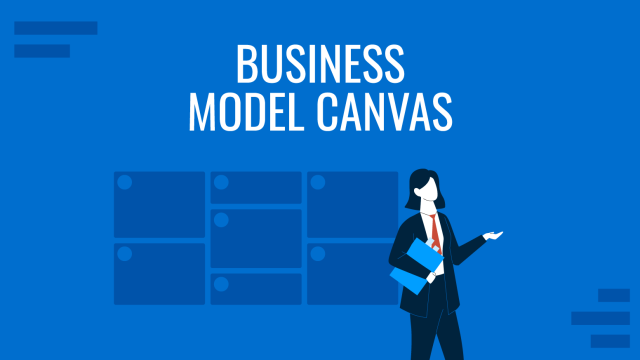The ultimate goal of any business is to grow and scale. Conquering a single market or customer segment is never enough. Companies need to innovate to expand further, and many innovations involve operational risks. Will investing $X in this new feature pay off?
What should we propose to consumer group X to sell to them effectively? These are just a few questions a Go-to-Market strategy is designed to answer.

Table of Contents
- What is a Go-to-Market Strategy?
- When do you need to prepare a Go-to-Market Strategy?
- Key components of a Go-To-Market Strategy
- Importance of Go-to-Market Strategy
- Different Go-to-Market Strategies
- How to write a Go-to-Market Strategy
- Real-Case applications of the Go-to-Market Strategy
- How to present a Go-to-Market Strategy?
- Conclusion
What is a Go-to-Market Strategy?
A Go-to-Market Strategy (GTM Strategy) is a tactical framework that breaks down all the steps necessary to develop a successful go to market strategy and succeed in a new market or audience segment. You can create GTM plans for pretty much any entrepreneurial endeavor – new product/services launch, startup launch, or brand re-launching, or even create a plan for expanding to a brand new market.
To some extent, a Go to Market Strategy is a more crystallized take on your marketing plan, but it comes with a more detailed scope and a higher focus on just one product or service. Typically, it addresses the execution of a specific growth strategy for pushing your business forward.
When do you need to prepare a Go-to-Market Strategy?
Despite their size and industry, most businesses tend to adopt the following four market strategies to scale. All of them assume careful market planning, but not every one of them requires you to create a full-scale Go to Market strategy:
Penetration
Your business wants to sell more existing products/services at your primary market. You already know your consumer base/market well enough, so the risks are low. At this point, you will need to prepare a new marketing strategy and marketing plan to reach more customers.
Expansion
You want to introduce new products/services to a new market through a Go to Market Strategy. To succeed and minimize the risks of failure, you will need to study the latest market carefully. Hence, it’s worth creating a comprehensive marketing strategy, Go to Market Strategy, and a marketing plan.
Innovation
Are you planning to launch a brand new product/service in your existing market? You will have to carefully weigh the pains, gains, and value of this new offer you will create. Prepare a GTM, a marketing strategy, and a marketing plan.
Aggression
Are you entering new markets with new products/services? An aggressive growth strategy assumes high risks and potentially high rewards for businesses. To pull off conquest, you will need to study the new markets, work out the best deliverables, develop a marketing strategy plan, and Go to Market Strategy.
Bonus tip
Use an Ansoff Growth Matrix to analyze your market strategy and determine the various risks associated with pursuing one or another Go To Market plan.
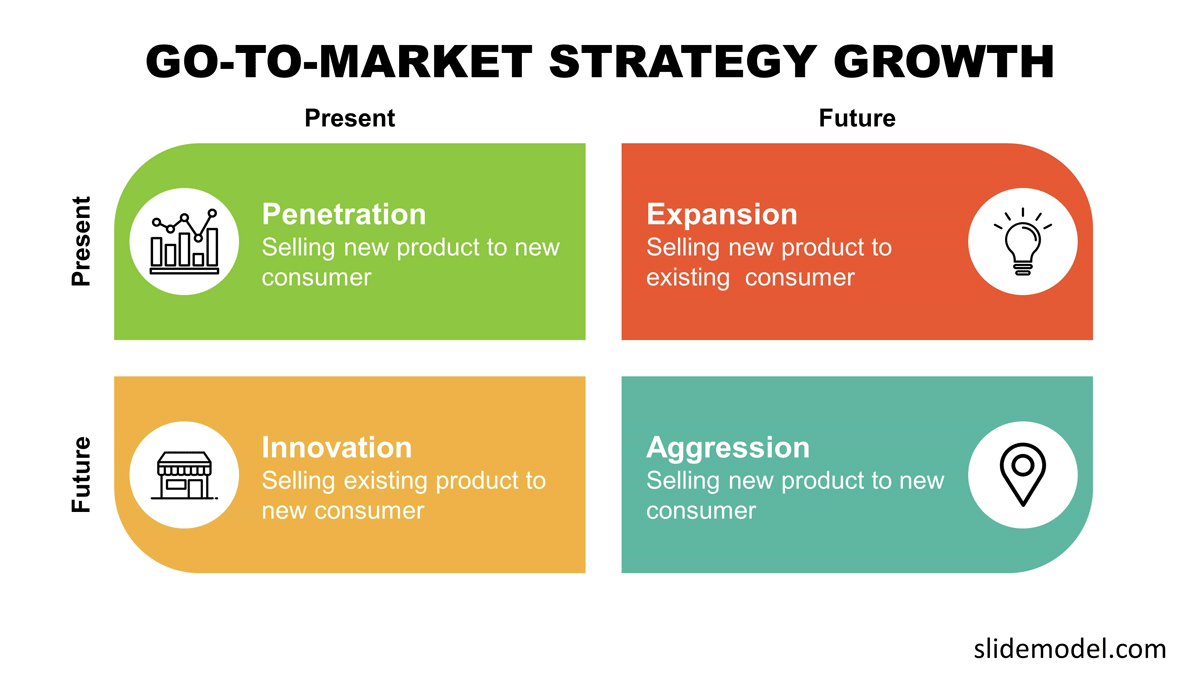
Different Go-to-Market Strategies
When it comes to launching a product or service, there is no one-size-fits-all approach. Different situations call for different Go-to-Market (GTM) strategies. These strategies are designed to help companies successfully introduce their offerings to the market and gain a competitive edge. Here are some key GTM strategies to consider:
Direct Sales
In a direct sales GTM strategy, a company sells its products or services directly to the end customer. This approach is often used for high-value, complex solutions that require personalized interactions. It’s commonly employed in industries like enterprise software, where sales representatives engage with potential clients to understand their needs and tailor offerings accordingly.
Channel Sales
Channel sales involve partnering with intermediaries, such as distributors, retailers, or value-added resellers, to reach the target audience. This strategy can help companies tap into established distribution networks and leverage the expertise of partners to expand their market reach. Consumer electronics and software applications are examples of products often distributed through channel sales.
Online Sales (E-commerce)
E-commerce has transformed how products are marketed. Companies can set up online stores to directly reach customers, making it a cost-effective GTM strategy for digital products, physical goods, and even services. Effective online marketing, user-friendly websites, and seamless transactions are crucial components of this approach.
Freemium Model
Popular in the software industry, the freemium model offers a basic version of a product or service for free and charges for premium features or upgrades. This GTM strategy allows companies to attract a broad user base and monetize through upselling to those who need more advanced features. It’s an effective way to create a large user community and generate recurring revenue.
Partnerships and Alliances
Collaborating with other businesses through partnerships and alliances can open up new market opportunities. This strategy involves leveraging strategic partners’ customer base, expertise, or resources to jointly bring products to market. Joint ventures, co-marketing agreements, and strategic alliances fall under this category.
Product-Led Growth
For digital products like SaaS (Software as a Service), the product-led growth strategy centers around offering a self-service, user-friendly experience. Users can sign up, try the product, and upgrade without direct sales interactions if satisfied. Word-of-mouth, referrals, and online communities are pivotal in driving growth in this GTM strategy.
Vertical-Specific Strategy
Some businesses may opt for a vertical-specific GTM strategy, focusing exclusively on a particular industry or niche market. This approach involves tailoring products, marketing, and sales efforts to meet the unique needs of a specific sector, thereby gaining a competitive advantage.
Geographical Expansion
Companies looking to expand their reach internationally can adopt a geographical expansion GTM strategy. This involves carefully analyzing new markets, adapting products or services to local preferences and regulations, and establishing a presence in those regions.
Customer-Centric Approach
A customer-centric GTM strategy revolves around deeply understanding customer needs and preferences. It involves gathering customer feedback, conducting market research, and continuously refining products and marketing to meet customer expectations.
Key components of a Go-To-Market Strategy
Strong business case
Why are you launching this product or planning to enter a specific market? What are you hoping to gain? Studying your business case through these questions will help you understand the reasons for your Go to Market Strategy. You will discover new insights that will open doors to new ways of launching your product to the market.
Market strategy
Where will your new offer sit, and how do you plan to engage customers in the new market?
- Unique value proposition: What sets you apart from the competition? What will make the consumer choose you over another brand?
- Product/Brand positioning: How will customers view your product in regards to others, e.g., do you plan to position yourself as a luxury alternative to service XYZ?
- Messaging: What are your brand’s main talking points when it comes to solving customer problems? Narrow it down to three very specific issues you will tackle.
- Sales and support model: What tools, resources, and materials will you need to promote, support, and sell your offering?
- Customer journey: How does the typical sales cycle look? What are the common buyer behaviors at different stages of their decision process? What can you do to meet them halfway?
- Customer Personas: How does your ideal buyer look – age, demographics, income, shopping preferences?
- Product use cases: How will your target audience use your products/services?
Pricing
How will your pricing strategy work? Do you plan to use discounts/promos to stand out in the new market? The pricing strategy allows you to study the market and understand the consumer’s willingness to pay for your product or service. This way, you will find the balance point between market supply and demand and effectively apply it to your Go to Market Strategy.
Pricing is both a financial and a branding decision. Indeed, your pricing tiers should correspond to your business model, but they should also indicate what kind of value you are delivering for that figure. What type of message will your price communicate? Are you offering premium quality for the premium costs? Or will you try to beat your competitors by providing a cheaper alt solution – the route most go-to-market strategies for startups embrace?
Your pricing will further impact your overall sales strategy. If you plan to hit the market with a more sales-intensive (premium) product, you will need to dwell on this section a bit longer and create a detailed outline of your sales process. Consider visualizing it using a 7 Steps of Buying And Selling Process PowerPoint template for extra clarity.
Customer Acquisition
What would be your sales model and approach to generating new business? Will you operate as a DTC (Direct to Consumer) brand or through resellers? Developing a Customer Acquisition strategy will allow you to understand the type of customer you want to deliver your message to and which channels will reach your company.
Customer engagement and retention
How will you nurture repeat business, increase the lifetime value of customers (LTV), and re-activate/re-engage existing clients? A retention and loyalty strategy is essential to satisfy existing customers, generate new revenue from complementary products and generate new referrals.
Product Roadmap
How will you develop and introduce a new offering to the market? How will you decide on product improvements or added features? Generating a Product Roadmap will help you define a budget and a development strategy. It is a plan that allows you to establish how your product will achieve specific business objectives and the approach to achieving them. Discover other roadmap templates and timeline templates to develop your strategy.

Marketing Plan
What marketing strategies/channels do you plan to use to generate the buzz around your brand? Your plan should include:
- Branding
- Lead generation
- Content + website builder
- Inbound/Outbound marketing
- PR strategy
Budget and Resources + KPIs/Metrics
Decide on the key milestones in your go-to-market strategy and set KPIs for measuring the success of your initiative.
How to Write a Go-to-Market Strategy
Before you spell out your plan and turn it into a detailed Go to Market strategy presentation, you need to do some deep-level research. A Go to Market strategy is a relatively short document but encapsulates more refined details. To simplify the process, you can start using a Go to Market strategy PowerPoint template (similar to the one outlined above, which is available for Microsoft PowerPoint and Google Slides) and start piling up your data step-by-step. So, how to do a go to market strategy? Here are the information elements your GTM strategy needs to cover.
Product-Market Fit
The first thing you’ll want to cover is your Product-Market Fit. Strategize what problems your offer will solve for customers and how you will validate their need for that specific solution. “Umbrellas for lefties” may sound like a good idea on paper because there are a lot of left-handed people, and it rains a lot in your state…but do lefties actually need a special umbrella? Perhaps not. Coming up with a precise Product-Market may be a research-heavy stage, but failing to cover it properly can translate to failure. According to CB Insights analysis, almost half (42%) of startups failed because their solution didn’t address a valid customer concern.
Conduct a SWOT analysis
Through a SWOT Analysis, you will discover your strengths, opportunities, weaknesses, and threats. This analysis will give you new points of view about your business, and, at the same time, you will be able to find new insights and ideas to develop in the future.
For more information, read our article about how to create a strategy presentation.
Analyze your competitors and create a competitive matrix
Understanding who your competitors are and how they position themselves in the market will provide you with valuable information. You will discover areas of innovation and differentiation to generate a unique value proposition. You will identify your competitors, products, and commercial strategy through a Competitive Matrix.
Define any partners who can help you get early traction
If you are launching a new brand or product to the market, the best strategy you can choose is to find well-positioned partners that will allow you to generate branding, legitimize your brand and multiply. Find new allies that offer supplementary products, make medium and long-term alliances, and develop a joint growth strategy.
Target Audience and Customer Personas
You will need to understand your target audience and individual buyers clearly. Without this, you will fail to create an actionable, ROI-driven marketing strategy and engage with your prospects.
Conduct customer research
Customer research may take time as you’ll need to schedule interviews and perhaps run several surveys with focus groups. Still, this effort pays off in the long run – 71% of businesses that exceed their revenue and lead gen goals have documented customer personas.
Define an ideal customer persona
The customer persona is your ideal customer. Through customer research, you will discover their profile and know their objectives, challenges, pain points, and objections. At the same time, you will obtain valuable demographic information. Their socioeconomic level, age, gender, hobbies, and interests are where they live. This information will allow you to generate communication strategies better focused on this type of customer.
Define an ideal customer journey plan
On the other hand, the customer journey represents the stages of a user’s purchase decision process until becoming a customer. Having a good customer journey that includes awareness, consideration, decision, and retention is vital for your business to prosper and grow in the medium and long term.
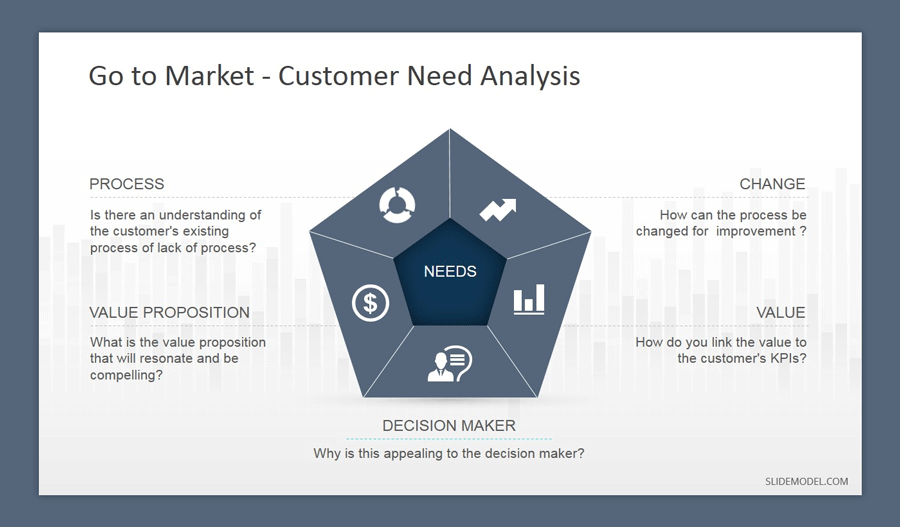
Competition and Positioning
Whether you are entering a new market, prepping for a new product launch, or preparing a pre-launch strategy, you will need to know who you are standing against on the battlefield. Your market strategy should address the current market trends (plus emerging ones) that may affect your product launch and the state of competition, and which other players will likely respond to your entry.
Come up with your unique value proposition (UVP)
The unique value proposition aims to provide a clear and transparent idea of how the business can be relevant to the customer and solve their needs. This practice, usually performed by the Marketing area, will give you a clear idea of how your business should communicate with your ideal customer and highlight how your value proposition is different from the rest of the competition. This step is key to differentiating and communicating your strengths and opportunities as a company.
In short, a good value proposition should summarize:
- What problems will it solve for the customer (relevancy)?
- What benefits will they get as a result (quantifiable value)?
- Why should the customer buy from you, not your competitor (unique differentiation)?
Your value proposition should be further reinforced by product/brand positioning. To create a clear, concise positioning statement, follow the following formula:
- [Target Audience] – for shoppers who love a great bargain.
- [Marketing Strategy] – Plugin X is an affordable, easy-to-use SaaS tool for collecting discounts.
- [Problem-Solving] – that helps you find stores and track all the discounts, sales, and promos happening in your favorite stores
- [Message Strategy] – the advertising of Plugin X should emphasize the convenience and time-saving of using the tool and appeal to the FOMO of missing a sale.
Define your brand identity
Brand identity is a significant factor for market positioning. Being easily recognized by a color, a logo, or an image is one of the most challenging tasks for a marketing team. Defining the graphic elements that make up the brand is essential to follow a clear line of communication from the beginning.
Distribution and Marketing Strategy
What will be your channels for distributing your products? Do you plan to be digital-only or set up a storefront? How will your sales process work? Create a list of preliminary sales strategies templates that you will later validate with your team and stakeholders.
Define your product marketing strategy
A solid product marketing strategy template includes defining the product’s line of communication, a clear pricing strategy, establishing content distribution channels, and content promotion and amplification strategies.
Define your launch strategy
It is necessary to define an expectation campaign to prepare users for the moment of the launch and execution. Without expectation, there will be no successful launch. At the same time, once the new product or service has been launched, it is necessary to carry out a post-launch campaign not to be forgotten by the public. An agile execution can bring more flexibility to get the work done.
Define your KPIs (Key Performance Indicators)
Actions that are not measured cannot grow. Based on this premise, it is significant to know that precise and concrete KPIs must be defined to successfully apply all of the above. These indicators of success will vary depending on the category, product, or service you want to offer.
A good measure is:
- Quantifiable. You can attach a number to it or measure the results in another way.
- Meaningful. The metric is tied to a specific business goal, and most stakeholders agree.
- Motivational. Your team has a clear benchmark they can aspire to reach.
- Operational. You should measure the effects of the changes you make quickly.
Go to Market strategies can also include additional sections such as a product roadmap, budget/resources, and product support. Depending on your needs, you may want to have these for more significant insights.
Real-Case Applications of the Go-to-Market Strategy
Up to this point, the ideas and strategies explained in this article may sound too abstract. For that very reason, we wish to share an exemplification from three different companies in Go-to-Market strategies.
Vuclip
Vuclip is a video-on-demand service mobile platform targeted at emerging markets, currently counting more than forty million users.
Key Points:
- The Internet can be a scarce resource in emerging markets, mostly due to economical limitations or technological delays. Some countries in Africa and Asia still heavily rely on 2G and 3G networks.
- “Must-have” mobile streaming market.
- The main pain point is video buffering.
Applying a GTM Strategy Growth Matrix, we can structure their approach as follows:
- Present/Present – Penetration: Creating a new video-on-demand service for countries with limited internet access.
- Present/Future – Expansion: Convincing consumers that Vuclip is a viable alternative to YouTube, accessible from any mobile device.
- Future/Present – Innovation: Selling a video-on-demand service accessible via the web from a mobile platform, with no extra technological requirements than what they currently own.
- Future/Future – Aggression: The company appeals to be a consumer brand rather than an enterprise model to reach a broader market share. Also, by keeping the consumer the main point of interest, the service’s quality helps as a testimonial on why new customers should sign up for this service.
EightSleep
EightSleep is a well-established company in the health services market whose products target a common issue for people worldwide: sleep deprivation. Through cutting-edge technology, they give sleep insights via a mobile app, customize the temperature of your mattress, and apply gentle methods as an alternative to loud alarms.
What’s important from a GTM Strategy point of view is their integration with the IFTTT service (an app that applies an ‘if-then’ logic to integrate different applications and trigger automatic actions).
Their GTM Strategy Growth Matrix would be seen as follows:
- Present/Present – Penetration: Email announcement to their potential customer base during the pre-launch phase, explaining the IFTTT integration. Creating a dedicated landing page to expose the benefits and estimated usage cases.
- Present/Future – Expansion: Promotional videos on Facebook and Instagram target younger audiences. Those videos exposed the integrations with IFTTT routines, such as turning on a speaker when you wake up to have your preferred music around in the very early morning.
- Future/Present – Innovation: Selling a product that’s fully compatible with mobile apps, which allows the consumer to customize their sleep experience to their needs and reduces the need for sleep supplements to gain quality sleep time.
- Future/Future – Aggression: Due to them working with IFTTT, they were included in their recommended gift guide products at the time of launch, driving a spike in traffic and sales conversion. The marketing strategy eventually moved through technological partnerships, getting an endorsement from Mercedes AMG Petronas Formula 1 team in aiding them to preserve their sleep fitness.
Huawei
The Chinese telecom giant Huawei experienced a hard challenge in accessing the Indian market. Considered the biggest market available in the world, India was one key point for the expansion strategy of Huawei outside China; still, diplomatic relationships between both countries couldn’t be considered their best point when entering the market.
Key Points:
- Culturally, Chinese products were perceived as low-quality and subpar in comparison with India’s local production.
- B2B relationships between China and India were complex. Their contrasting approaches to business models made it uneasy to form partnerships.
- India’s massive talent pool in software development and electronics.
If we analyze this situation through a GTM Strategy Growth Matrix, we would have this scenario:
- Present/Present – Penetration: Building a local R&D department in India and service center facilities. This brought employment opportunities from a tech giant to India, acknowledging their skillset and giving back to the community.
- Present/Future – Expansion: Bangalore, India, hosts the second-largest research center for Huawei outside China.
- Future/Present – Innovation: By establishing trust, China was able to overcome cultural challenges and position itself as an affordable solution for mobile devices.
- Future/Future – Aggression: Converting the product into a coveted item by the mass audience. Huawei initially built its marketing strategy around the concept of why they sell quality products in comparison with low-end Chinese goods, getting an endorsement from native English communities.
How to Present a Go-to-Market Strategy?
First of all, before creating a presentation, it is vital to define its objective. In the case of Go to Market Strategy, there can be two hypotheses:
The first is to present a go-to-market plan and convince the collaborators about the program you wish to carry out. The second scenario is when the go-to-market plan is already approved, and you want to inform and generate action in your team to present a roadmap and divide tasks.
All presentations are based on these three pillars: convince, inform or generate action. It is essential to keep this in mind as it will help you have a clear objective when presenting your Go to Market Strategy.
However, when it comes to generating a presentation about Go to Market Strategy, all presentations have some points in common.
The following are some examples of Go-to-Market (GTM) strategy components, including a go to market strategy example, that you can present to your audience. When crafting your go-to-market strategy, it’s essential to have a clear plan in place to ensure the successful launch of your product or service. One crucial aspect of this strategy is understanding your target market and how to reach them effectively. Let’s delve into a go-to-market strategy example to illustrate this concept.
Discussion of the Marketing Strategy
Creating a marketing strategy involves several discussions around three main questions:
- What to Sell?
- How to Sell?
- Where to Sell?
The following diagram is very popular in corporate planning to initiate the Go-To-Market Strategy discussion and definition.

The diagram’s purpose is to navigate the questions in each vertex and evaluate the central concept in the edges.
The process will follow this reasoning:
When analyzing “What to sell?” and “How to Sell?”, the discussion will orbit around Customers. Conversations will be triggered around the value proposition and what product will satisfy the Customer’s needs. Also, how will those customers acquire the product, and how will the organization generate awareness for them?
Moving clockwise, the discussion will switch to the question “What to Sell?” and “Where to Sell?”; in this case, the central concept to discuss will be the market. The analysis team will need to strategize the possible segments the product will be marketed in and which channels will be used for marketing and delivery.
Finally, in the last circular movement, the analysis will turn into the Product concept by asking “Where to Sell?” and “How to Sell?“.
Market Problem Identification
Whenever you are penetrating a market, existing or new, you need to find the product-market fit. Explaining the product-market fit is essential in your go-to-market strategy. You can use the Market Problem Identification Slide from SlideModel to describe the market need and the capabilities of your product/service that satisfy it.
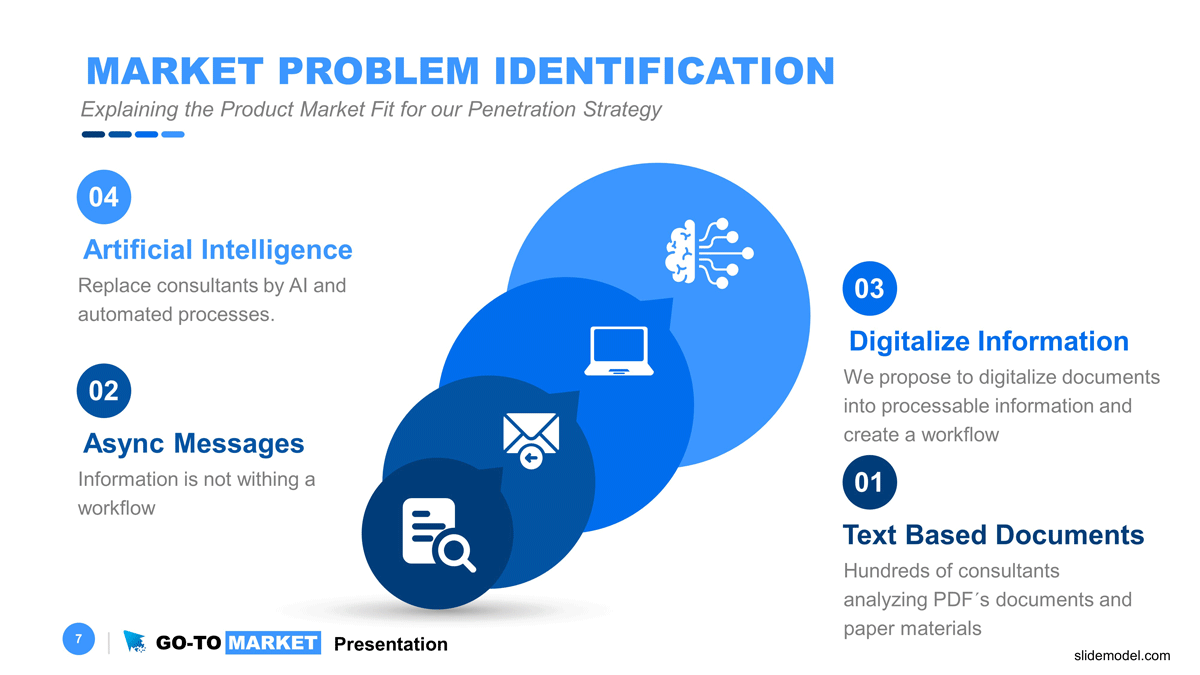
Product Definition, 6 Ps Marketing Mix
Every Go-To-Market Strategy needs to present the Marketing Mix offered. In this section, the presenter will describe:
- The Product-Service being marketed
- The pricing strategy selected.
- The places where the customers can acquire the product/service.
- How it will be promoted to generate awareness.
- The teams that will work the funnel.
- Which presentation will be used to display the product in the marketplace.
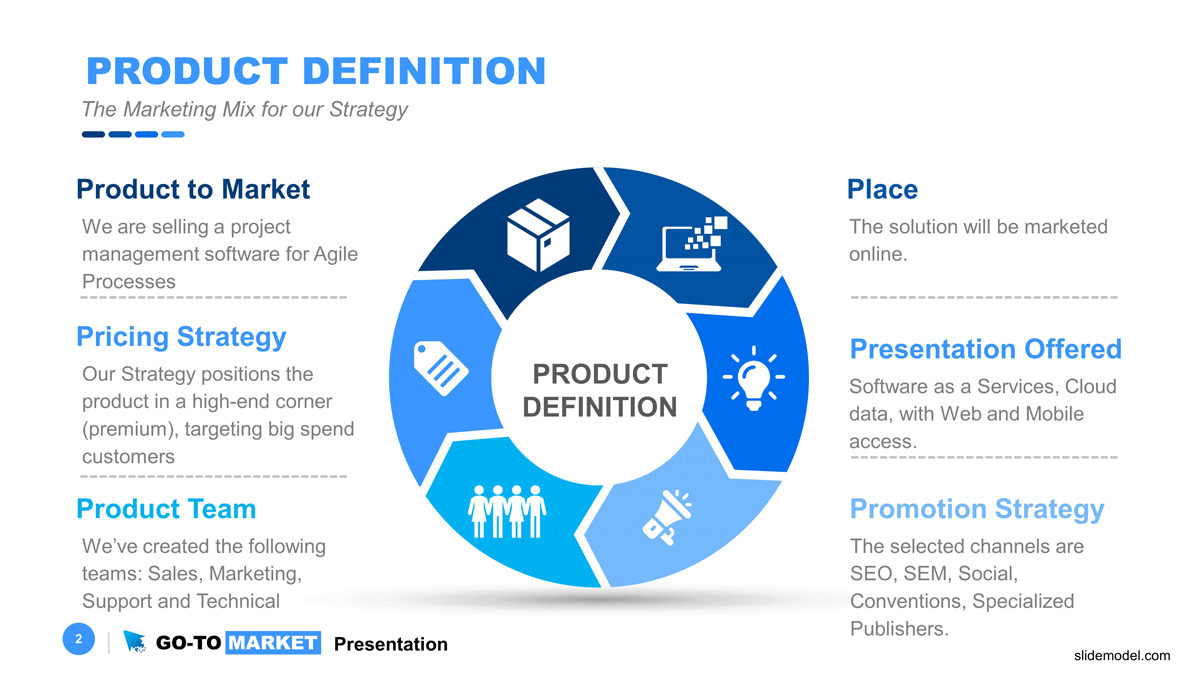
Market Segmentation
The analysis team will generate a high-level market segmentation during the Go-To-Market Strategy definition. The following diagram presents the four dimensions selected to build the initial segments. At this point, the organization is at the strategy level, so there is no further drill down in segments or persona analysis. These aspects will be defined during the Marketing Plan.
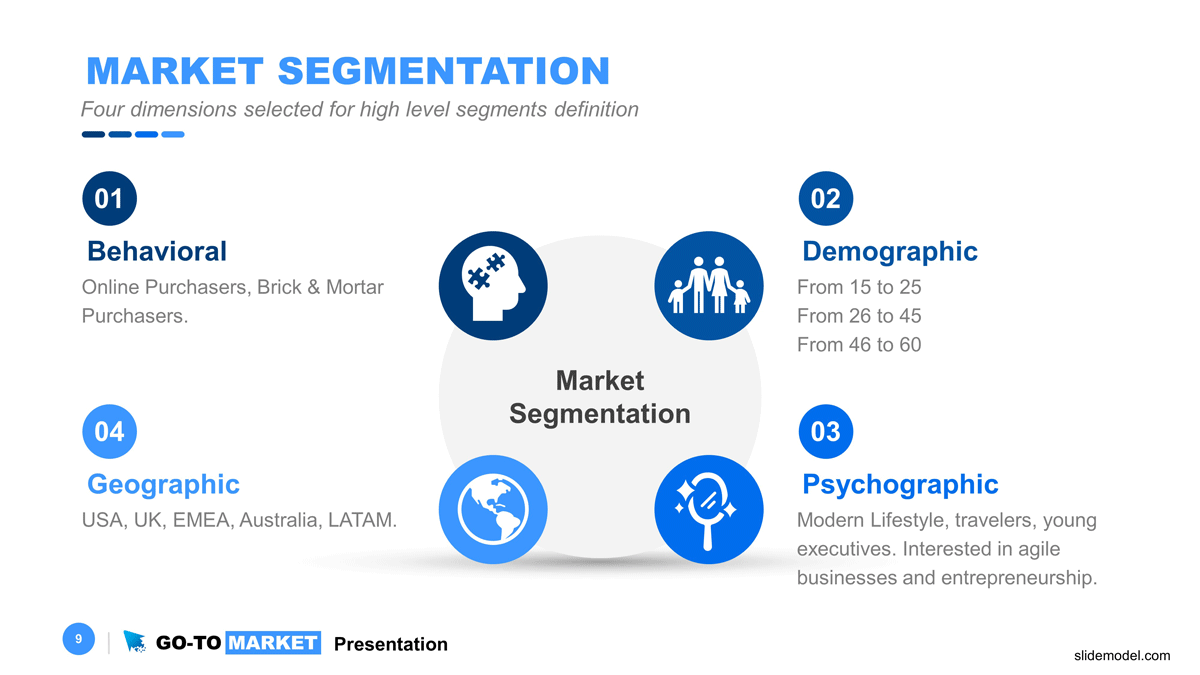
Partners Analysis
Analyzing the partnerships required for a successful go-to-market is essential. The diagram provides a framework for generating quality conversations around the partnering strategy. The model offers four main concepts:
- Value for Partner
- Selection Criteria
- Management Process
- Network Profile.
The intersection of each concept generates quadrants where the analysts will position the organization compared to the partner being analyzed. The quadrants measure:
- Right-Up: Evaluate the value delivered to the partner and how the relationship benefits the organization’s goals towards the product/service.
- Right-Down: Evaluate the process’s effort and the related impact on the organization’s goals towards the product/service.
- Left-Down: Evaluate the required knowledge of the industry by the network and the effort of managing the process.
- Left-Up: Evaluate the Value provided to the partner versus how the industry’s knowledge benefits the organization’s goals.
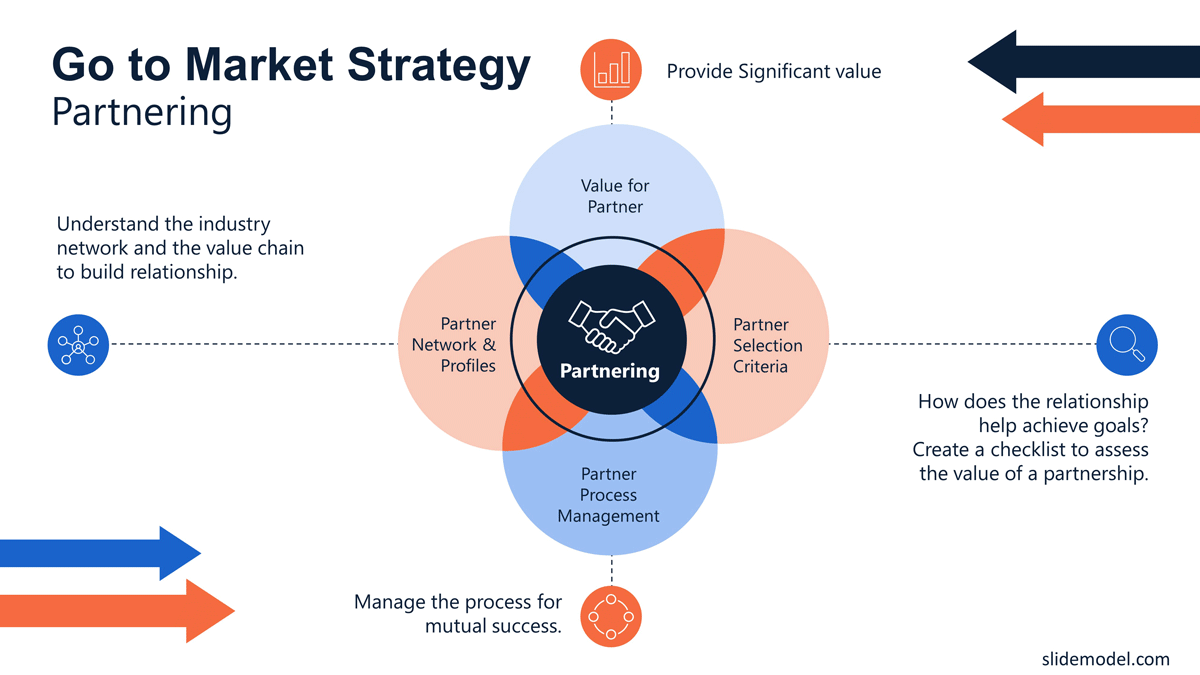
Product Roadmap
Every Go To Market strategy should discuss possible Roadmaps for the Product/Service. From launch to adoption, it’s essential to have guidelines on how to proceed on the different maturity levels.
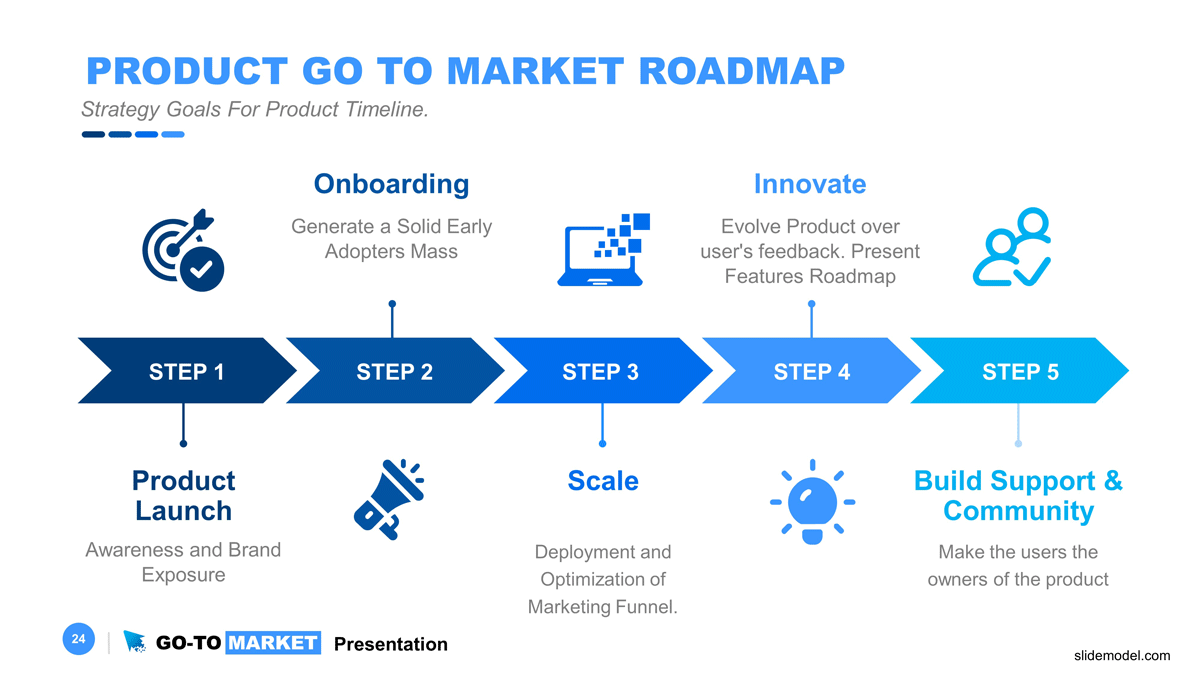
Conclusion
A Go to Market strategy helps you create a clear path for launching new products/services and carefully assess your future operations’ aspects. Apart from solidifying your business vision, it helps you look at your offerings from the customers’ perspective and work out the optimal presentation and marketing of your new products. Your GTM strategy should help you minimize the risks of blowing up the launch and, as a result, the customers’ trust and affinity towards your brand. Visit our wide variety of PowerPoint Templates to create your go-to-market strategy in a professional way.

